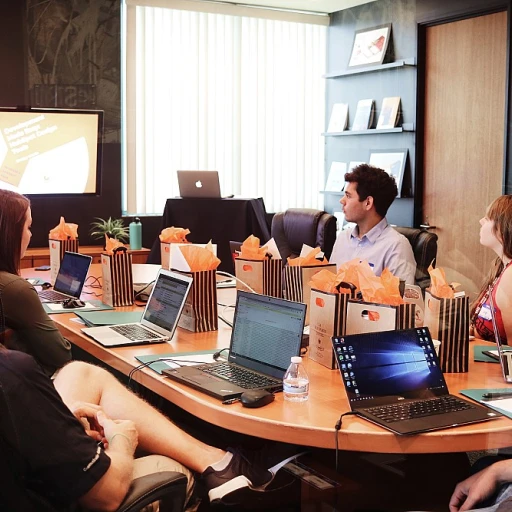
Understanding the Importance of Reskilling
The Core of Reskilling: Why it Matters
Understanding the need for reskilling is crucial for any organization aiming to stay competitive in today's fast-paced business environment. The landscape is constantly shifting, and businesses need to adapt to survive. Companies that succeed are those that recognize the necessity of reskilling their workforce. It's not just about keeping pace; it's about leading the charge in efficiency and innovation. Incorporating reskilling into a company's succession planning process ensures a seamless transition of roles, nourishing employees to become future leaders. By doing so, organizations can maintain their competitive edge while cultivating talent from within, thus creating high-potential employees ready for increasingly complex roles. Why is Reskilling Important?- Business Continuity and Growth: In any business succession, having a ready pool of skilled employees ensures that the company can withstand market changes and sustain growth.
- Talent Management and Development: A robust reskilling plan nurtures potential successors, leading to effective leadership development.
- Adaptation to Technological Advancements: Keeping up with technology requires continuous learning, which reskilling naturally supports.
- Elevating Employee Morale: A commitment to employee development boosts morale and increases retention rates. Employees appreciate when a company invests in their future, driving loyalty and performance.
Identifying Key Roles and Skills
Pinpointing Essential Positions and Abilities
Identifying key roles and skills within your organization is a crucial step in crafting an effective succession plan. In the business landscape, the ability to nurture and develop leaders is vital for ensuring a seamless transition of responsibilities. It's essential to assess your current talent pool to determine which positions hold significant importance for future growth and sustainability. To kickstart the planning process, perform a thorough analysis of your existing organizational structure. Identify critical positions and roles that are integral to maintaining your company’s competitive edge. This necessitates looking beyond simply high-ranking roles and considering key contributors at various levels. A few steps can guide your assessment:- Conduct a Comprehensive Role Analysis: Break down the current functions and responsibilities of each role. Understanding what each position entails helps recognize the skills required for future leaders.
- Evaluate Current Performance: Leverage performance management tools to identify potential successors among your current employees. Examine their contributions, growth potential, and readiness for additional responsibilities.
- Engage with Current Leaders: Consult with those currently in leadership positions to get insights on their day-to-day roles and the requirements needed to perform effectively.
Developing a Tailored Succession Plan
Creating a Succession Plan That Meets Organizational Needs
Developing a tailored succession plan is vital for ensuring the continuity and growth of any organization. This process revolves around the careful identification and development of key roles and potential leaders within your company, aligning them with the future needs of the business. A well-crafted succession blueprint not only addresses current leadership roles but also anticipates the future requirements of your organization. The goal is to establish a strategic framework that serves both immediate talent needs and long-term objectives, an approach sometimes overlooked in smaller businesses. Here’s a structured approach to designing a personalized succession plan:- Define Organizational Objectives: Clearly outline the long-term vision and objectives of the company. Understanding where your business is headed will provide insight into the skills and roles necessary for future succession.
- Evaluate Current Leadership: Conduct a thorough analysis of existing leadership and key positions. Assess how these roles contribute to the overall business strategy and identify any skill gaps or areas for development.
- Develop Key Roles and Competencies: Identify key roles that are crucial to your business’s performance. Create a detailed profile for each role outlining the required skills, competencies, and leadership qualities.
- Identify High-Potential Employees: Use performance management and talent management tools to identify employees who demonstrate strong leadership potential. These individuals are often the best candidates for development plans and future leadership positions.
- Create a Personalized Development Plan: Tailor a succession and development plan for each potential successor. This may include job rotations, mentoring programs, and specialized training.
Implementing Reskilling Programs
Launching Reskilling Initiatives
Implementing reskilling programs is a critical step in ensuring your organization is prepared for future challenges. By focusing on the development of your employees, you can create a robust talent pipeline that supports your succession planning efforts. Here are some best practices to consider:
- Assess Current Skills: Begin by evaluating the existing skill sets within your organization. This will help identify gaps and areas for improvement, ensuring that your reskilling efforts are targeted and effective.
- Design Customized Programs: Tailor your reskilling programs to meet the specific needs of your business and employees. This might involve creating a development plan that aligns with your succession plan, ensuring that high potential employees are prepared for future leadership roles.
- Utilize Diverse Learning Methods: Incorporate a variety of learning methods, such as workshops, online courses, and mentorship programs, to cater to different learning styles and preferences. This approach will enhance engagement and improve the overall effectiveness of your reskilling initiatives.
- Leverage Technology: Use technology to facilitate learning and track progress. Learning management systems and other digital tools can help streamline the planning process and provide valuable insights into employee development.
- Encourage a Culture of Continuous Learning: Foster an environment where learning and development are prioritized. Encourage employees to take ownership of their growth and provide them with the resources and support they need to succeed.
Aligning Reskilling with Business Goals
To ensure the success of your reskilling programs, it is essential to align them with your organization's long-term objectives. This alignment will help you identify key roles and potential successors, ensuring that your succession planning efforts are effective and sustainable. Consider the following strategies:
- Integrate with Talent Management: Reskilling should be an integral part of your overall talent management strategy. By aligning your reskilling efforts with performance management and leadership development initiatives, you can create a cohesive approach to employee growth.
- Focus on Future Leaders: Identify employees with high potential and provide them with targeted development opportunities. This will help prepare them for leadership positions and ensure a smooth transition when key roles become vacant.
- Monitor and Adjust: Regularly review the effectiveness of your reskilling programs and make adjustments as needed. This will help you stay agile and responsive to changing business needs, ensuring that your organization remains competitive in the long term.
Monitoring Progress and Adapting Strategies
Tracking the Journey and Refining the Approach
Monitoring the progress of your reskilling efforts and adapting your strategies are essential steps in managing an effective succession plan. The dynamic nature of business environments necessitates frequent evaluation to ensure the development plan aligns with organizational goals and the needs of potential future leaders. To support the ongoing assessment, consider implementing a robust performance management system. This system should capture key metrics relevant to the roles being developed and the employees' growth. Regular check-ins between leaders and employees can help identify areas of improvement and adjust development strategies as needed.- Evaluate Skill Acquisition: Regular assessment of employees' acquisition of key skills is vital. Use templates to systematically review their progress and integrate feedback into future planning processes.
- Employee Feedback: Involving employees in succession planning helps uncover any discrepancies in role expectations and personal development aspirations. This collaborative approach not only refines skill development plans but also boosts employee engagement.
- Training Efficiency: Measure the efficacy of reskilling programs by comparing training outcomes with initial objectives. This will highlight successful strategies and areas that need refinement within your planning templates.
- Leadership Review: Scheduling leadership evaluations provides insights into whether your talent management efforts are on track to produce high-potential successors. As these individuals transition into key roles, your organization's capability to fill critical positions strengthens.
Overcoming Challenges in Reskilling and Succession Planning
Addressing Obstacles for a Smoother Transition
Crafting an effective succession plan for reskilling presents numerous challenges that organizations must strategically navigate to ensure success. While the identification of key roles and skills and developing a tailored succession plan are pivotal, overcoming barriers in this process is crucial for long-term business sustainability.
One of the predominant challenges lies in resolving resistance to change. Employees, particularly those in leadership or key positions, might feel threatened by the emerging talent deemed potential successors. Transparent communication and the involvement of current leaders in the reskilling journey can alleviate these concerns and foster a culture of growth and development within the organization.
Another challenge is the integration of comprehensive talent and performance management systems into the succession planning process. A successful plan relies on accurate performance metrics and talent assessments, which necessitate invested time and effort to implement and maintain. Leveraging technology and data analytics can streamline this process, providing invaluable insights into employee potential and leadership development needs.
Misalignment between reskilling programs and business goals is an often-overlooked hurdle. Succession planning templates should incorporate clear connections to the organization’s strategic objectives, ensuring that the skills developed are aligned with future roles and leadership needs. Regularly updating these plans to reflect shifting priorities ensures their relevance and effectiveness.
Engaging employees in development plans can be difficult, particularly in smaller businesses where resources may be limited. Offering incentives for participation in reskilling initiatives, such as career advancement opportunities, can encourage engagement and demonstrate the organization's commitment to employee development.
Lastly, ensuring the implementation of best practices in succession planning involves a commitment to continuous learning and adaptation. Leveraging planning examples from industry leaders and customizing them to fit the unique culture and values of the organization can enhance the planning process. Organizations should embrace an iterative approach, refining their succession and reskilling strategies to meet evolving needs and capitalize on high-potential talent.













